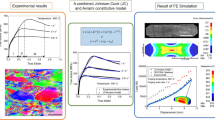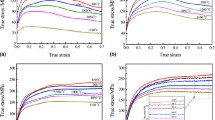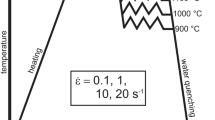Abstract
The flow behavior of nanoquasicrystalline \(\hbox {Al}_{93}\hbox {Fe}_{3}\hbox {Cr}_{2}\hbox {Ti}_{2}\) alloy at different strain rates and elevated temperatures was represented by the Johnson–Cook model, a modified Johnson–Cook model, a newly modified Johnson–Cook model, and a modified Zerilli–Armstrong model. A comparative study on the capability of the four models to accurately predict the flow stress of the alloy at hot deformations is made using standard statistical parameters correlation coefficient (R) and average absolute relative error (AARE). The results show that the newly modified Johnson–Cook model provides predicted stresses that agree very well with the experimental stresses at the tested domain of strain rates and temperatures, with R = 0.979 and AARE = 7.78%. The modified Zerilli–Armstrong model might predict the flow stress of the alloy but at some of the tested domain of strain rates and temperatures, with R = 0.951 and AARE = 9.13%. The Johnson–Cook model and the modified Johnson–Cook model are found to be inadequate to predict the flow stress of the alloy with R of 0.924 and 0.935 and AARE of 12.72% and 10.73%, respectively.











Similar content being viewed by others
References
Chlup Z, Todd I, Garcia Escorial A, Lieblich M, Chlupova A, O’Dwyer J (2003) Bulk nanostructured aluminium alloy Al93Fe3Cr2Ti2: processing and characterisation. In: THERMEC’2003. Materials science forum, vol. 426. Scientific.Net, Switzerland, pp 2417–2422
Todd I, Chlup Z, O’Dwyer JG, Lieblich M, Garci’a-Escorial A (2004) The influence of processing variables on the structure and mechanical properties of nano-quasicrystalline reinforced aluminium alloys. Mater Sci Eng A 375:1235
Escorial AG, Cremaschi V, Natale E, Lieblich M (2007) Thermal evolution of nanoquasicrystalline \(\text{Al}_{93}\text{Fe}_3\text{Cr}_2\text{Ti}_2\) alloy. J Alloys Compd 434:215
Inoue A, Kimura H (2000) High-strength aluminum alloys containing nanoquasicrystalline particles. Mater Sci Eng A 286(1):1
Pedrazzini S, Galano M, Audebert F, Smith G (2017) Elevated temperature mechanical behaviour of nanoquasicrystalline \(\text{Al}_{93}\text{Fe}_3\text{Cr}_2\text{Ti}_2\) alloy and composites. Mater Sci Eng A 705:352
Zhang C, Zhao G, Chen H, Guan Y, Kou F (2012) Numerical simulation and metal flow analysis of hot extrusion process for a complex hollow aluminum profile. Int J Adv Manuf Technol 60(1):101
Bastani AF, Aukrust T, Brandal S (2011) Optimisation of flow balance and isothermal extrusion of aluminium using finite-element simulations. J Mater Process Technol 211(4):650
Parvizian F, Kayser T, Hortig C, Svendsen B (2009) Thermomechanical modeling and simulation of aluminum alloy behavior during extrusion and cooling. J Mater Process Technol 209(2):876
Gagliardi F, Citrea T, Ambrogio G, Filice L (2014) Influence of the process setup on the microstructure and mechanical properties evolution in porthole die extrusion. Mater Des 60:274
Yu J, Zhao G, Chen L (2016) Analysis of longitudinal weld seam defects and investigation of solid-state bonding criteria in porthole die extrusion process of aluminum alloy profiles. J Mater Proc Technol 237:31
Yu J, Zhao G, Cui W, Zhang C, Chen L (2017) Microstructural evolution and mechanical properties of welding seams in aluminum alloy profiles extruded by a porthole die under different billet heating temperatures and extrusion speeds. J Mater Proc Technol 247:214
Zhou J, Wang B, Huang M (2014) Two constitutive descriptions of boron steel 22MnB5 at high temperature. Mater Des 63:738
Mandal S, Rakesh V, Sivaprasad P, Venugopal S, Kasiviswanathan K (2009) Constitutive equations to predict high temperature flow stress in a Ti-modified austenitic stainless steel. Mater Sci Eng A 500(1):114
Wei G, Peng X, Hadadzadeh A, Mahmoodkhani Y, Xie W, Yang Y, Wells MA (2015) Constitutive modeling of Mg–9Li–3Al–2Sr–2Y at elevated temperatures. Mech Mater 89:241
Johnson GR, Cook WH (1983) In: Proceedings of the 7th international symposium on ballistics, vol 21, The Netherlands, pp 541–547
Zerilli FJ, Armstrong RW (1987) Dislocation-mechanics-based constitutive relations for material dynamics calculations. J Appl Phys 61(5):1816
Zhang H, Wen W, Cui H, Xu Y (2009) A modified Zerilli–Armstrong model for alloy IC10 over a wide range of temperatures and strain rates. Mater Sci Eng A 527(1):328
Samantaray D, Mandal S, Bhaduri A (2009) A comparative study on Johnson Cook, modified Zerilli–Armstrong and Arrhenius-type constitutive models to predict elevated temperature flow behaviour in modified 9Cr–1Mo steel. Comput Mater Sci 47(2):568
Chen L, Zhao G, Yu J (2015) Hot deformation behavior and constitutive modeling of homogenized 6026 aluminum alloy. Mater Des 74:25
Wang J, Zhao G, Chen L, Li J (2016) A comparative study of several constitutive models for powder metallurgy tungsten at elevated temperature. Mater Des 90:91
Zhao Y, Sun J, Li J, Yan Y, Wang P (2017) A comparative study on Johnson–Cook and modified Johnson–Cook constitutive material model to predict the dynamic behavior laser additive manufacturing fecr alloy. J Alloys Compd 723:179
Lin Y, Chen XM, Liu G (2010) A modified Johnson–Cook model for tensile behaviors of typical high-strength alloy steel. Mater Sci Eng A 527(26):6980
Shokry A (2017) A modified Johnson–Cook model for flow behavior of alloy 800H at intermediate strain rates and high temperatures. J Mater Eng Perform 26(12):5723
Samantaray D, Mandal S, Borah U, Bhaduri A, Sivaprasad P (2009) A thermo-viscoplastic constitutive model to predict elevated-temperature flow behaviour in a titanium-modified austenitic stainless steel. Mater Sci Eng A 526(1):1
Pedrazzini S, Galano M, Audebert F, Collins D, Hofmann F, Abbey B, Korsunsky A, Lieblich M, Escorial AG, Smith G (2016) Strengthening mechanisms in an Al–Fe–Cr–Ti nano-quasicrystalline alloy and composites. Mater Sci Eng A 672:175
Shokry A, Ståhle P (2015) A methodology for using Kalman filter to determine material parameters from uncertain measurements. Mater Discov 2:1
Li HY, Li YH, Wang XF, Liu JJ, Wu Y (2013) A comparative study on modified Johnson Cook, modified Zerilli–Armstrong and Arrhenius-type constitutive models to predict the hot deformation behavior in 28CrMnMov steel. Mater Des 49:493
Trimble D, O’Donnell GE (2015) Constitutive modelling for elevated temperature flow behaviour of AA7075. Mater Des 76:150
Phaniraj MP, Lahiri AK (2003) The applicability of neural network model to predict flow stress for carbon steels. J Mater Process Technol 141(2):219
Srinivasulu S, Jain A (2006) A comparative analysis of training methods for artificial neural network rainfall–runoff models. Appl Soft Comput 6(3):295
Author information
Authors and Affiliations
Corresponding author
Additional information
Technical Editor: Paulo de Tarso Rocha de Mendonça, Ph.D.
Publisher's Note
Springer Nature remains neutral with regard to jurisdictional claims in published maps and institutional affiliations.
Rights and permissions
About this article
Cite this article
Shokry, A. On the constitutive modeling of a powder metallurgy nanoquasicrystalline Al93Fe3Cr2Ti2 alloy at elevated temperatures. J Braz. Soc. Mech. Sci. Eng. 41, 118 (2019). https://doi.org/10.1007/s40430-019-1617-y
Received:
Accepted:
Published:
DOI: https://doi.org/10.1007/s40430-019-1617-y




